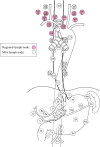Japanese Classification of Esophageal Cancer, 12th Edition: Part I
- PMID: 38568243
- PMCID: PMC11199297
- DOI: 10.1007/s10388-024-01054-y
Japanese Classification of Esophageal Cancer, 12th Edition: Part I
Abstract
This is the first half of English edition of Japanese Classification of Esophageal Cancer, 12th Edition that was published by the Japan Esophageal Society in 2022.
Keywords: Chemotherapy; Endoscopic treatment; Esophageal cancer; Japanese classification; Radiotherapy; Surgery.
© 2024. The Author(s).
Figures
































References
-
- Brierley JD, Gospodarowicz MK, Wittekind C. TNM classification of malignant tumours. 8. New York: Wiley-Blackwell; 2017.
-
- Oyama T, Momma K, Makuuchi H. Japan esophageal society classification of superficial esophageal squamous cell carcinoma (in Japanese) Endosc Dig. 2012;24:466–468.
MeSH terms
LinkOut - more resources
Full Text Sources
Medical
